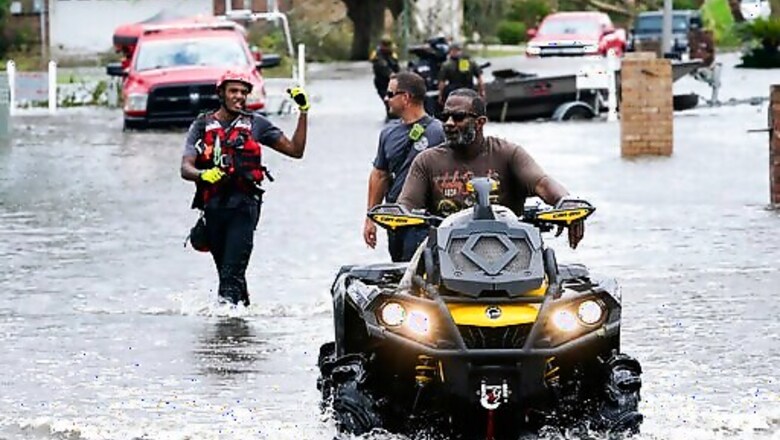
views
NEW ORLEANS: The levees, floodwalls and floodgates that protect New Orleans held up against Hurricane Ida’s fury, passing their toughest test since the federal government spent billions of dollars to upgrade a system that catastrophically failed when Hurricane Katrina struck 16 years ago.
But strengthening the flood protection system in New Orleans couldn’t spare some neighboring communities from Ida’s destructive storm surge. Many residents of LaPlace, a western suburb where work only recently began on a long-awaited levee project, had to be rescued from rising floodwaters.
Marcie Jacob Hebert evacuated before Ida, but she has no doubt that the storm flooded her LaPlace home based on what she has seen and heard from neighbors. Her house didn’t flood in 2005 during Katrina, but it took on nearly 2 feet (60 centimeters) of water during Hurricane Isaac in 2012.
We havent had these problems until everybody else’s levees worked,” said Hebert, 46. “It may not be the only factor, but I sure do think it contributes.
Christina Stephens, a spokesperson for Gov. John Bel Edwards, said the pumps in New Orleans were working on generator power Monday and operating properly.
The levee system worked the way it was supposed to, she said.
Two flood protection districts oversee the system in Orleans, Jefferson and St. Bernard parishes. Neither district reported any breaches or overtopping of levees.
The system performed as designed, said Nicholas Cali, regional director of the Southeast Louisiana Flood Protection Authority-West, which oversees the west bank of Orleans and Jefferson parishes. We are still completing inspections but so far have zero evidence of overtopping or structural issues.
The Southeast Louisiana Flood Protection Authority-East, which covers St. Bernard Parish and most of Orleans and Jefferson parishes, also planned to inspect its system Monday but hadn’t found any problems, according to regional director Kelli Chandler. A surge barrier opened Monday morning to allow maritime traffic through a major shipping channel, she said.
“It was an intense storm and the levee systems functioned as designed,” Chandler said. We start preparing for a storm the day after the last one ended, and thats exactly what were going to do today.
Tulane University history professor Andy Horowitz, author of Katrina: A History, 1915-2015, said it is “unequivocally great news that the levees held up against Ida’s surge. That doesn’t mean that a city as vulnerable as New Orleans is safe from flooding in the face of a changing climate, he added
It does not mean that the lesson of Hurricane Ida is that metropolitan New Orleans has adequate hurricane protection. It means it had adequate protection against this storm surge, Horowitz said. “As the system is challenged by stronger and more frequent hurricanes. I think many experts are very concerned about the rather low level of protection that New Orleans has.”
A federal judge in New Orleans ruled in 2009 that the U.S. Army Corps of Engineers’ failure to properly maintain and operate the Mississippi River-Gulf Outlet, a navigational channel known as MR-GO, was a significant cause of the catastrophic flooding during Katrina. Levee failures near Lake Pontchartrain also flooded New Orleans neighborhoods.
After Katrina, the federal government spent $14.5 billion on projects designed to enhance protection from storm surge and flooding in New Orleans and surrounding suburbs south of Lake Pontchartrain. Starting with a giant surge barrier east of the city, the system is a 130-mile (210-kilometer) ring built to hold out storm surge of about 30 feet (9 meters).
Work recently began on a levee project to protect tens of thousands of residents of LaPlace and other communities outside New Orleans’ levee system. That project is not projected to be completed until 2024.
Im glad theyre building us a levee, but I worry about what happens to the next group further to the west,” Hebert said. “The water has got to go somewhere. We cant just keep funneling it from person to person, place to place.
Bernardo Fallas, a spokesperson for Phillips 66, said the company did not immediately have information about whether a reported levee collapse in Plaquemines Parish affected its Alliance Refinery in Belle Chasse. Fallas said the refinery has been shut down since Saturday, ahead of Idas arrival. We will proceed to conduct a post-storm assessment of the refinery when it is safe to do so, Fallas said.
___
Kunzelman reported from College Park, Maryland. Amy reported from Atlanta. Associated Press writers Michael Biesecker in Washington and Melinda Deslatte in Baton Rouge contributed to this report.
Disclaimer: This post has been auto-published from an agency feed without any modifications to the text and has not been reviewed by an editor
Read all the Latest News, Breaking News and Assembly Elections Live Updates here.



















Comments
0 comment